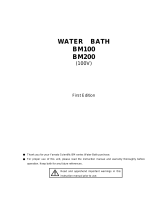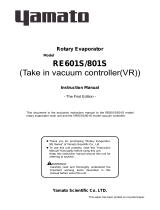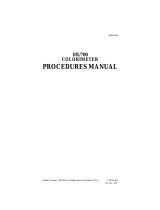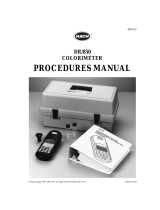Page is loading ...

ROTARY EVAPORATOR
RE440
RE540
(100V)
First Edition
Thank you for your Yamato Scientific RE series Rotary Evaporator purchase
For best test data, we recommend you purchase our BM series Water Bath.
Please call Yamato Scientific for more details.
Read and apprehend the important warnings in
this instruction manual prior to use.

Table of Contents
1. Specifications ....................................................................................................................................1
2. Safety Information..........................................................................................................................1-5
Safety Symbols………………………………………………………………………….…1
Safety Precautions………………………………………………………………………3-4
Hazardous Material………………………………………………………………………..5
3. Identification of Parts………………………………………………………………………………………6
4. Installation/Assembly…………………………………………………………………………………..7-15
Assembling parts
………………………………………………………………..….
7-11
Removing the Evaporation Flask and Steam Duct………………………….……….12
Lift…………..…………………………………………………………………………..…13
Vacuum Hose and Water Supply………………………………………………………14
Power Requirements …………………………………………………………….……..15
5. How To Operate…………………………………………………………………………………………….16
6. Troubleshooting Guide...................................................................................................................17
Problem Solving Chart………………………………………………………………….17
7. Wiring Diagram ................................................................................................................................18
8. Lists of Exchange Parts..................................................................................................................21
9. After Sale Service and Warranty....................................................................................................22
Request for Repair…………………………………………………………………….…22

1
1. Specifications
Type RE440 RE540
Rotation Speed *1
20 180rpm
Accuracy of display
rotation speed *1
3rpm(at 20 180rpm)
Drive system Worm gear system
Rotation speed
display system
Digital
Resolution of rotation
speed display
1rpm
Movable Steam Duct Mechanism, Flask Remover
Other Supplemental System
Power Socket ( for Vacuum Controller )
Glass Joint 29/38 Steam Duct, S35/20 Receiving Flask
Lift Mechanism Electric motor auto lift
Motor(rotation) Induction motor 25W
Glass set Type A, Type B, Type C
Safety device Overcurrent protection ( fuse 2A )
Exterior dimensions
(W D H) *2
420 340 580 mm
Weight 13kg 14kg
Power source (RE only)
AC100V 10% 50/60Hz 2 A
Option
Evaporation Flask (opaque & frosted
29/42)
2000ml/500ml/300ml/200ml/100ml
Receiving Flask ( opaque & frosted S35/20)
2000ml/500ml/300ml
Joint (opaque & frosted )
29/42-29/38, 29/42-24/40, 29/42-19/38,
29/42-15/25, 24/40-24/40
Trap Ball (opaque & frosted )
29/42-29/38, 29/42-15/25, 24/40-24/40
Combination apparatus
Water Bath BM100/200/400
Oil Bath BO600
*1 The rotation speed indicates performance of the unit equipped with (A, B or C type) glass set in case
of unloaded operation under rated power.
*2 Glass set is not included.

1
2.
Safety Information
Safety Symbols
Graphic indications
This instruction manual and our products apply various indications for safety. Ignoring these
indications can cause such situations as listed below. Read and understand the following warning and
caution signs in this manual prior to use.
WARNING
Indicates the possibility of serious or fatal injury (Note 1).
CAUTION
Indicates the possibility of injury (Note 2) or damage (Note 3) to the
equipment.
(Note 1) Serious injury : Bodily harm by electric shock, bone fracture or poisoning which may require
hospitalization.
(Note 2) Injury : Bodily harm by electric shock, bone fracture or poisoning which may not require
hospitalization.
(Note 3) Damage : Any damage on equipment, facility, structure, etc.
Meaning of Graphic Indications
Shows warning or caution.
Specific contents are described aside each sign.
Shows users important information not to do.
Specific contents are described aside each sign.
Shows users important information sure to do.
Specific contents are described aside each sign.

2
Safety Information
Safety Precautions
If the motor overloads - stop operation immediately.
If you continue operation under abnormal overload conditions, the motor may stop by the safety
device. If the motor stops, turn the volume knob to the minimum and cut the switch off.
Overload means the situation when the motor surface heats up more than 90 due to
rust on ball bearing etc.,
Make sure that the volume knob indicates “min” before turning the unit on.
Make sure that the volume knob is at “min”. If the volume knob is not turned to “min”, the
evaporation flask turns round when you turn on the power switch.
Move the lift up or down after you stop rotation of the evaporation flask.
If the lift is moved up or down while the evaporation flask is rotating, scalding may occur due to
dispersing of hot water. Be sure to move the lift after turning the volume knob to the minimum.
Never fail to ground the unit.
This unit uses a 3-core power cord (including ground wire). Be sure to ground the unit for safety.
Be cautious using flammable chemicals.
This unit is not explosion proof. Do not use in flammable or explosive gas environments and do
not evaporate explosive substances.
The flask clamp is very springy. Be careful not to break the glass apparatus.
The enclosed flask clamp is very springy to hold the glass apparatus firmly. Be careful not to
break the glass.

3
Safety Information
Safety Precautions
Only water to be used with the Water Bath.
Only water in the Water Bath. Problems can occur if anything other than water is used. Also be
sure not to heat with low water level or the bath can overheat.
Use a trap.
Use a trap when you decompress by hydraulic rotary vacuum pump. When you use our Handy
Aspirator, fill to overflow.
Maintain the vacuum seal.
The vacuum seal is expendable. Exchange the seal in case of vacuum-down.
You can use the vacuum seal without grease. But you desire more longer life of the seal, put
silicon grease onto the ripped side of vacuum seal. If you are afraid of sample contamination,
use liquid sample.
Cleaning the exterior of RE series evaporator
Do not use any volatile chemicals to clean the exterior of this unit. This could damage the color
and shape. Wipe clean with a soft dry towel , etc.-Do not use a brush.
If the unit is not in use for a long period of time, cut the power supply.
If the unit is not in use for a long period of time, turn the power off and pull out the power cord for
safety.

4
Safety Information
Hazardous Material
Do not use the Unit in flammable or explosive gas environments of substances
listed below. Do not evaporate explosive substances.
Nitroglycol, Nitroglycerin, Nitrocellulose, and other explosive nitric
esters.
Trinitrobenzene, Trinitrotoluene, Picric acid, and other explosive nitro
compounds.
Peracetic acid, Methyl ethyl ketone peroxide, Benzoyl peroxide, and
other organic peroxides.
Explosive
Explosive
Substance
Sodium azide, and other metallic azides
Combustible
Substance
Metallic lithium, Metallic potassium, Metallic sodium, Yellow
phosphorus, Phosphorus sulfide, Red phosphorus, Celluloid,
Calcium carbide, Lime phosphate, Magnesium powder, Aluminum
powder, and other combustible metal powders and sodium dithionite
(hydrosulfite).
Potassium chlorate, Sodium chlorate, Ammonium chlorate, and
other chlorates.
Potassium perchlorate, Sodium perchlorate, Ammonia perchlorate,
and other perchlorates.
Potassium peroxide, Sodium peroxide, Barium peroxide, and other
inorganic peroxides.
Potassium nitrate, Sodium nitrate, Ammonia nitrate, and other
nitrates.
Sodium chlorite and other chlorites.
Oxidant
Calcium hypochlorite and other hypochlorites.
Ethyl ether, Gasoline, Acetaldehyde, Propylene Oxide, Carbon
disulfide, and other flammable substances with a flash point below
minus 30ºC.
Normal hexane, Ethylene oxide, Acetone, Benzene, Methyl ethyl
ketone, and other flammable substances with a flash point between
minus 30ºC and 0
o
C.
Methanol, Ethanol, Xylene, Pentyl acetate (amyl acetate), and other
flammable substance with a flash point between 0ºC and 30ºC.
Ignitable
Substance
Kerosene, Light oil, Turpentine oil, Isoamyl alcohol, Acetic acid, and
other flammable substances with a flash point between 30ºC and
65ºC
Flammable
Combustible
Gas
Hydrogen, Acetylene, Ethylene, Methane, Ethane, Propane, Butane
and other flammable gas at 15 degree and under 1 atmosphere.

5
3. Identification of Parts
With Condenser A
RE440 (type A)
RE540 (type A)
Stand
Volume Knob
Vacuum Regulator VR100
Vacuum Pipe
Opening to Pour
Sample
Cooling Water
Pipe
Cock
Cooling Tube (type A)
Flask Clamp
Rotary Joint Holder
Flask Clamp
Flask Remover
Motor
Distilling Flask
Water Bath BM400
Control Box
Tachometer

6
Identification of Parts
With Condenser B
RE440 (type B)
RE540 (type B)
Connecting Tube
Cooling Tube Holder
Cooling Tube Holder Shaft
Cooling Tube (type B)

7
Identification of Parts
With Condenser C
RE440 (type C)
RE540 (type C)
Please understand that our products are subject to some specification changes without notice.
The exterior design above are just examples of the interchangeable parts.
Cooling Tube (type C)
Cooling Tube Lid

8
4.
Installation/Assembly
1. Set the Body at a stable place.
Be sure to set the body at a stable place.
2. Fix the motor to the body.
1. Insert the motor bearing bar into the motor support clamp of the body, put D cut surface (flat
surface) of the bar perpendicularly to either 2 upper pr side screws, and fasten 4 fix screws tightly
by using the attached hexagonal wrench (for M5).
Then, slant the motor to the right (about 45 ), and fix the finger screw of the motor tightly.
If you do not fasten the screws tightly, vibration may occur preventing accurate
measurements or the motor may fall causing the glass apparatus to break.
2. Remove the cooling condenser nut (the bigger nut with the coil ring) and coil ring when you fix the
motor.
Finger Screw
Motor Support Clamp

9
Installation/Assembly
3. Inserting the steam duct into the motor
1.Before you insert the steam duct, make sure the O-rings inside the motor center hole are not out
of place. If so, reset them in the right place.
2.Insert the steam duct from the right side into the center hole of the motor.
3.Set the steam duct to the desired position with a minimum of 5mm between the blue flask
remover and the steam duct holder.
4.Tighten the steam duct holder by turning clockwise. Be sure to tighten the steam duct holder
firmly so that the steam duct does not slip.
When removing the steam duct, first loosen the steam duct holder. Do not remove the
steam duct holder or the rings may slip out.
If the rings come off in setting / removing the steam duct and you do not know how to
assemble…..
See the following picture to re-assemble.
Steam Duct Holder
Flask Remover
Keep at least 5mm
Rubber O- Rin
g

10
Installation/Assembly
4. Set the cooling condenser nut, coil ring and vacuum seal to the condenser or
condenser connector.
1. Remove the cooling condenser nut and coil ring on the left side of motor.
2. Connect the cooling condenser nut and then the coil ring to the condenser or condenser
connector (which ever applies). Be sure to put the nut on first.
3.Insert the vacuum seal to the condenser or condenser connector (which ever applies).
It is optional to put grease on the vacuum seal.
Insert the convex side of the vacuum
seal into the flange of cooling
condenser or condenser connector.
5. Connect cooling condenser or cooling condenser connector to the motor.
Insert the steam duct into vacuum seal, put glass flange to the motor and fasten firmly the cooling
condenser nut.
Be careful not to damage the set vacuum seal when you put steam duct into the flange
with the seal in case the damage could cause leak.
Glass Type A Glass Type B/C
Above :
Fitting of Coil Ring and Vacuum Seal
Below :
Fitting to Motor
Above :
Fitting of Coil Ring and Vacuum Seal
Below :
Fitting to Motor
When you remove the coil ring from cooling condenser or condenser connector
Hook the coil ring by the attached hexagon wrench as shown in the left
picture in order to remove the ring easily from the cooling condenser or
connecting condenser. However, be careful not to force too hard in case
the glass apparatus or the coil ring might be damaged.
Coil Ring
Vacuum Seal
Coil Ring
Vacuum Seal
Vacuum Seal
Cooling Condenser Nut
Coil Ring

11
Installation/Assembly
6. Connecting the cooling condenser holder shaft. (glass set B & C only)
Fit the cooling condenser holder shaft firmly into the screw hole on the back of motor. Put the
attached hexagon wrench through the hole on the end of shaft and fasten tightly.
7. Connecting the cooling condenser and condenser holder (B & C
condensers only)
1. Connect the cooling condenser to the condenser connector and hold by the cooling condenser
clamp.
2. Insert the cooling condenser holder from the top of condenser, while fitting the other side
through the holder shaft. (For type C, be sure to insert the cooing condenser holder from the
bottom of condenser rather than top and then connect the condenser to the condenser
connector)
3. Fit the suction cock for type B or the cooling condenser lid for type C.
Cooling Condenser Clamp
Cooling Condenser Holder
Suction Cock
Condenser Lid

12
Installation/Assembly
8. Connecting the Evaporation and Receiving Flasks.
Insert the evaporation flask into the steam duct and hold by the flask clamp. In addition, connect the
receiving flask in the same way by the flask clamp to the cooling condenser or condenser
connector.
Evaporation Flask
1. Turn the blue flask remover ring upward.
2. Connect the flask to the steam duct, and
hold by the evaporation flask clamp.
Receiving Flask
Connect the flask to the cooling condenser or
the connecting condenser, and hold by the
flask clamp.
9. Insert the feed tube to the cooling condenser or condenser connector.
Assembly is now complete.
Flask Clamp
Flask Clamp
Feed Tube

13
Installation/Assembly
Removing the Evaporation Flask and Steam Duct
10. Evaporation flask
Remover the flask clamp while holding the evaporation flask, and remove the evaporation flask
from the steam duct.
If the evaporation flask does not easily come off, use the blue flask remover.
For easy evaporation flask removal…
Turn the flask remover to touch the end of flask. Rotate further left and you can push out the
flask easily without force.
If you tap the flask to remove, the glass apparatus may break.
11. Steam duct
When you loosen the steam duct holder, the joint comes off easily.
Loosen the steam duct holder, but do not take it off when you remove the steam duct.
If you remove the holder, the rings will come off.
In case the rings should come off, and you do not know how to assemble them, see the chart
for re-assembly( P8 ).
Flask Remover
Flask Clamp

14
Installation/Assembly
Lift
12. How to operate the lift.
Easily move the lift up or down by using the lift switch located on the right side of the unit.
Operate the lift switch as follow;
To lift up
Push the upper side of the lift switch,
then the lift goes up.
Even if you let your hand off the
switch, the lift stops automatically.
To lift down
Push the lower side of the lift switch,
then the lift goes down.
Even if you let your hand off the
switch, the lift stops automatically.
The lift stops automatically at the upper or lower end of stroke.

15
Installation/Assembly
Vacuum Hose and Water Supply
13. Fit the hose joints to the water supply, drain and vacuum hoses at first, and
connect to the cooling water and vacuum pipes.
1. In case the joints are connected to the condenser, remove them.
2. Insert the hose joints into the water supply and drain hoses (inside diameter, 9mm) , hold by the
attached hose clamps and fix to the cooling pipes of cooling condenser.
In the same way, insert the hose joint into the vacuum hose (inside diameter of 6mm),fix to the
vacuum suction pipe (hose clamp is not necessary).
Do not fit the hoses to the hose joints connected to the condenser.
In case of glass A In case of glass B
In case of glass C
Connect the drain hose with the inside diameter
of 18mm to drain of cooling condenser.
Vacuum Hose
Water Supply and
Drain Hoses
Water Supply and Drain Hoses
Vacuum Hose
Vacuum Hose
Drain Hose( 18)

16
Installation/Assembly
Power Requirements
14. Connect the power plug into an outlet.
1. Connect the power cord of the body to AC100V power source.
Never fail to connect the earth for safety.
Be sure to switch off whenever you insert or pull out the power cord.
2. Then, joint the motor connecting cable to the socket on the back of controller.
15. Connect the vacuum controller, in case it is attached.
Prepare additionally an aspirator with displacement of 10 /min. as a vacuum device.
Combination with the vacuum controller VR100.
You can fix the vacuum controller, as shown in the
right picture, by metal fastener onto the controller
box of RE400/500 Rotary Evaporator.
In addition, you can connect the power cord of
VR100 to the power socket on the back of Rotary
Evaporator controller.
In case of RE200, you can not fix the vacuum
controller on RE200 and connect the power cord of
VR100 to RE200, so set and handle on a stable
place near by.
Look at the back panel of vacuum controller where hoses to connect are indicated. Follow the
indications and connect the hoses.
Be sure to read the attached instruction manual to handle the vacuum controller.
16. Prepare bath (separately sold)
Set the bath in front of the body, and pour water into it.
Be sure to read the attached operation manual to handle the bath.
BM400/BO600 BM200 BM100
RE400 or RE500
VR100

17
5. How To Operate
1. Pour cooling water/alcohol into the cooling condenser.
In case of glass A or B
Circulate the cooling water in the cooling condenser.
In case of glass C
Put dry ice and pour alcohol carefully so that it does not overflow.
2. Put sample into the evaporation flask.
Put sample into the evaporation flask.
Pour sample to fill the half of the evaporation flask capacity. Liquid collected in the
receiving flask shall be also kept within approximately the half level.
3.Heat the bath.
Set the bath temperature at the required degree and heat up to the set point.
4. Turn the power on, and operate the lift.
1.When the bath temperature reaches the set point, make sure that the volume knob stays at “min”,
and turn on the power switch on the right side of control box.
If, at this time, the volume knob is not at “min”, the evaporation flask rotates when you
turn the power on.
2.Operate the lift switch to put the evaporation flask gently into water bath, and determine the
adequate operational position.
5. Start rotation
Set the volume knob at the required speed to rotate. Operate the vacuum device as well for
evaporation.
When you supply sample during the unit operating
Connect the teflon tube (inside diameter 6mm) to the opening for sample and handle the cock to
let certain amount sucked in.
6. Move the lift up or down after you stop rotation of the evaporation flask.
If the lift is moved up from or down into the bath while the evaporation flask is
rotating, scalding may occur due to dispersing of hot water.
7. When the operation ends
When the operation ends and you want to remove the evaporation or receiving flask , open the cock
and bring back pressure inside the container to normal.
8. Operation after restarting from power failure.
The unit restarts the same operation as before after recovering from power failure.
/














